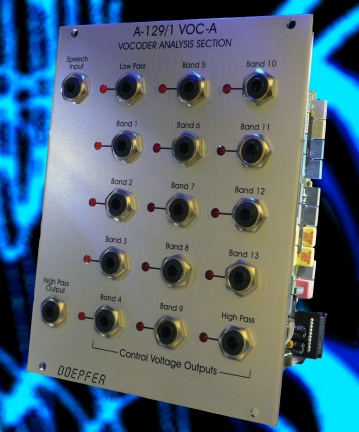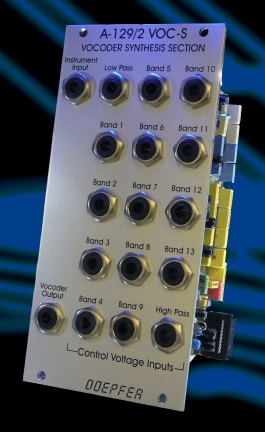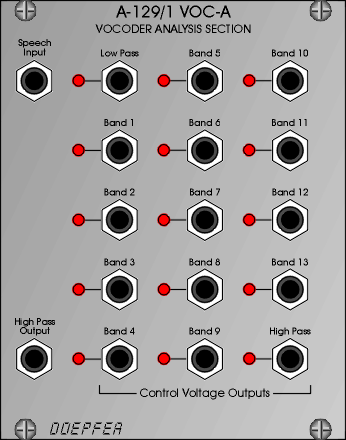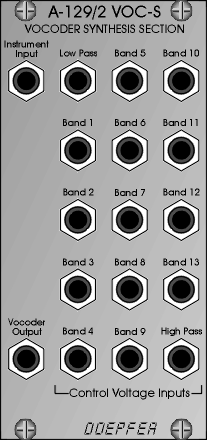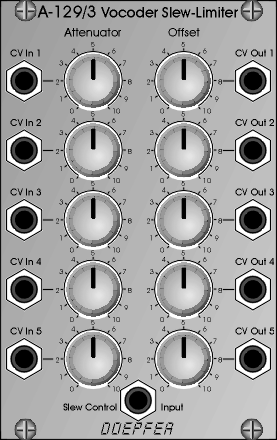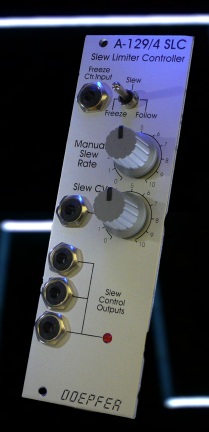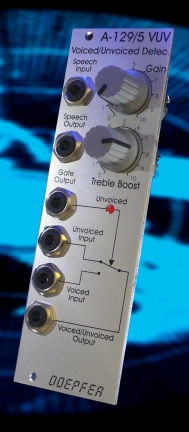A-129 Vocoder Subsystem
no
longer available

Working principle of a the Vocoder
The term vocoder is derived from the
words voice and coder. A
vocoder is an audio processor that captures the characteristic elements of
an an audio signal - normally a human voice - and then uses this
characteristic signal to affect another audio signal (e.g. a synthesized
sound like VCO or Noise). The technology behind the vocoder effect was
initially used in attempts to synthesize speech. The effect called
vocoding can be recognized on records as a "talking
synthesizer", made popular by artists such as KRAFTWERK. Pioneers of
electronic music took this concept and turned the vocoder into what it is
now - a tool for creative sound design. The vocoder works like this: The
sonic character of the analysis signal - i.e. normally human voice - is
extracted and transforms the signal at the vocoder's synthesis input. For
this, a set of filters, envelope followers and voltage controlled
amplifiers are needed, making good analogue vocoders very expensive.
More detailed the vocoder works like this: The voice signal is fed into
the vocoder's analysis input (A-129/1). This signal is sent through a set
of parallel filters with successive envelope followers that create a
"signature" of the input signal, based on the frequency content
and level of the frequency components. The signal to be processed (e.g.
VCO or Noise) is fed into the synthesis input of the vocoder (A-129/2) and
sent through an identical set of parallel filters with a separate VCA
(voltage controlled amplifier) behind each filter. The envelope follower
outputs of the analysis section are used to control the VCAs of the
synthesis section. The filter signature created during the analysis of the
human voice is used to filter the synthesized sound with a frequency
responce similar to the voice. Consequently the output of the vocoder
contains the synthesized sound modulated by the filter created by the
voice. One hears a synthesized sound that pulses to the tempo of the voice
with the tonal characteristics of the voice added to it: the synthesized
signal "talks".
For most of the standard vocoders the control voltages generated by the analysis section (envelope follower outputs) are connected to the VCA control inputs of the synthesis section. For the modular vocoder A-129 the control voltage outputs of the analysis section A-129/1 and the control voltage inputs of the synthesis section are available as jack sockets. This enables the user to process the control voltages with other modules (e.g. the slew limiter/attenuator/offset generator (see A-129/3 and A-129/4) to obtain functions not possible with a non-modular vocoders. Another advantage of the modular concept is the possibility to exchange or shift frequency bands. And the modular vocoder could be "abused" in many ways, e.g. by controlling, modifying or creating the control voltages with other A-100 modules (e.g. LFOs, S&H, Random CV, Shepard voltages) or even to record the "vocoding" with CV-to-MIDI and MIDI-to-CV interfaces (e.g. A-192 and A-191).
